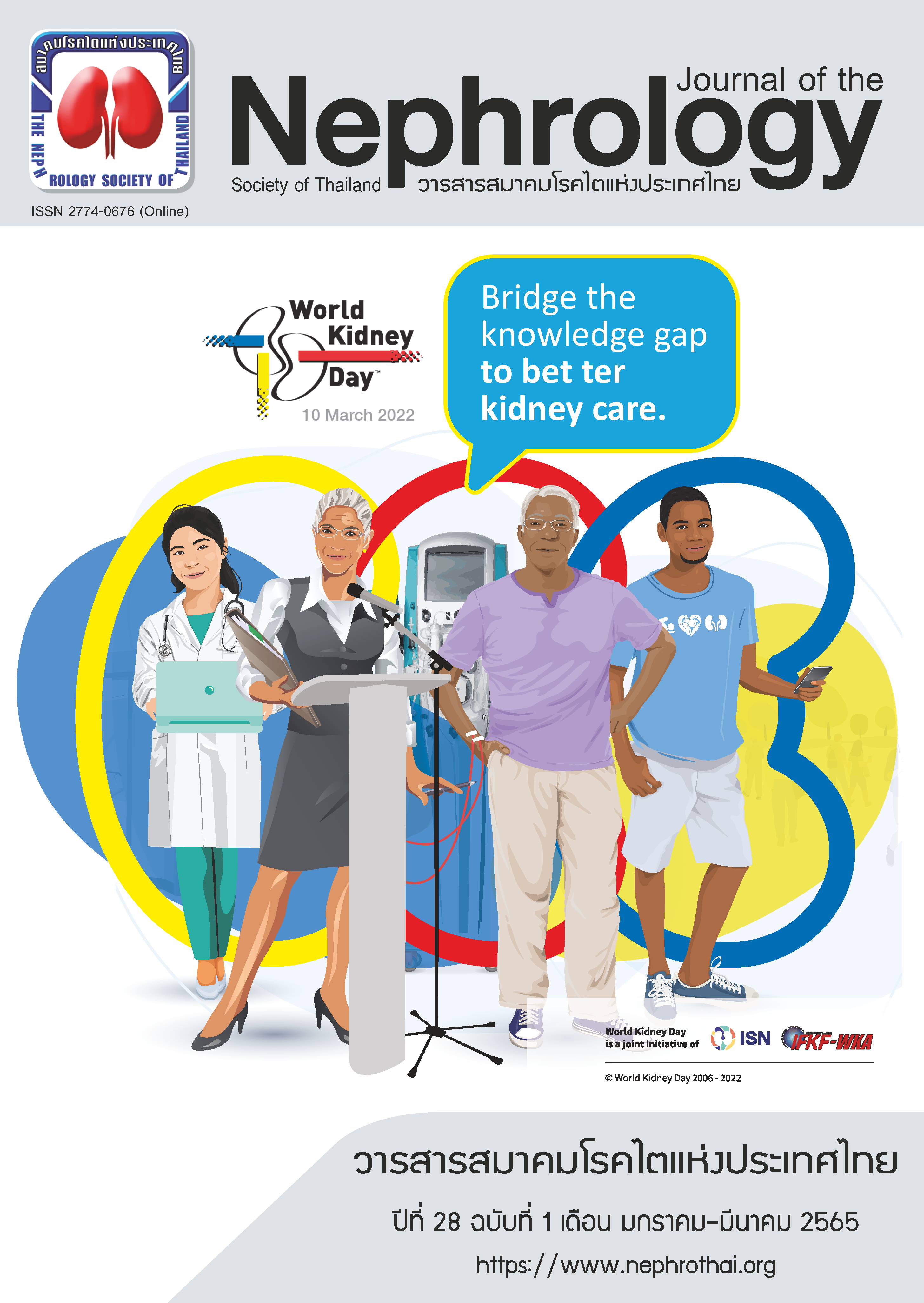Endothelin receptor antagonist in chronic kidney disease
Main Article Content
Abstract
Endothelin-1 is the most potent vasoconstrictor that regulates renal perfusion, controls glomerular arteriolar tone and stimulates inflammation and fibrosis leading to progressive chronic kidney disease. Endothelin-1 is derived mainly from endothelial cells and is synthesized by endothelin converting enzymes. Endothelin-1 activates through both endothelin A and endothelin B receptors. When activated through the endothelin A receptor, it results in vasculature vasoconstriction, mesangium proliferation, extracellular matrix accumulation, podocyte injury, proteinuria, tubulointerstitial fibrosis, inflammation and cell infiltration. In contrast, the outcomes of binding through the endothelin B receptor are vasodilation, decreased cellular proliferation and decreased inflammatory cells. Clinical studies report endothelin A-selective blocker has been demonstrated to reduce proteinuria, glomerular pressure and arterial stiffness in non-diabetic and diabetic kidney disease, particularly among patients taking angiotensin converting enzyme inhibitor or angiotensin receptor blocker at maximum tolerated dose. In conclusion, endothelin receptor antagonists represent promising drugs to delay progression in chronic kidney disease. Adverse effects such as fluid retention must be considered. This review article summarizes the pathogenesis of endothelins in chronic kidney disease and clinical trials of endothelin receptor antagonists.
Article Details

This work is licensed under a Creative Commons Attribution-NonCommercial-NoDerivatives 4.0 International License.
This article is published under CC BY-NC-ND 4.0 license, which allows for non-commercial reuse of the published paper as long as the published paper is fully attributed. Anyone can share (copy and redistribute) the material in any medium or format without having to ask permission from the author or the Nephrology Society of Thailand.
References
Clinical practice guideline for the evaluation and management of chronic kidney disease kidney disease: improving global outcomes (KDIGO). Kidney Int. 2013;3:1-150.
Dhaun N, MacIntyre IM, Melville V, Lilitkarntakul P, Johnston NR, Goddard J, et al. Blood pressure–independent reduction in proteinuria and arterial stiffness after acute endothelin-A receptor antagonism in chronic kidney disease. Hypertension. 2009;54(1): 113-9.
Wenzel RR, Littke T, Kuranoff S, Jürgens C, Bruck H, Ritz E, et al. Avosentan reduces albumin excretion in diabetics with macroalbuminuria. J Am Soc Nephrol. 2009; 20(3):655-64.
Mann JFE, Green D, Jamerson K, Ruilope LM, Kuranoff SJ, Littke T, et al. Avosentan for overt diabetic nephropathy. J Am Soc Nephrol. 2010; 21(3):527-35.
Kohan DE, Pritchett Y, Molitch M, Wen S, Garimella T, Audhya P, et al. Addition of atrasentan to renin-angiotensin system blockade reduces albuminuria in diabetic nephropathy. J Am Soc Nephrol. 2011;22(4):763-72.
de Zeeuw D, Coll B, Andress D, Brennan JJ, Tang H, Houser M, et al. The endothelin antagonist atrasentan lowers residual albuminuria in patients with type 2 diabetic nephropathy. J Am Soc Nephrol. 2014;25(5):1083-93.
Trachtman H, Nelson P, Adler S, Campbell KN, Chaudhuri A, Derebail VK, et al. DUET: A phase 2 study evaluating the efficacy and safety of sparsentan in patients with FSGS. J Am Soc Nephrol. 2018;29(11):2745-54.
Hiddo J L Heerspink H-HP, Dennis L Andress, George Bakris, Ricardo Correa-Rotter, Fan-Fan Hou, et al. Atrasentan and renal events in patients with type 2 diabetes and chronic kidney disease (SONAR): a double- blind, randomised, placebo-controlled trial. Lancet. 2019;393(10184):1937–47.
Yanagisawa M KH, Kimura S, Tomobe Y, Kobayashi M, Mitsui Y, Yazaki Y, et al. A novel potent vasoconstrictor peptide produced by vascular endothelial cells. Nature. 1988;332:411-5.
Kohan DE, Rossi NF, Inscho EW, Pollock DM. Regulation of blood pressure and salt homeostasis by endothelin. Physiological Reviews. 2011;91(1): 1-77
Vignon-Zellweger N, Heiden S, Miyauchi T, Emoto N. Endothelin and endothelin receptors in the renal and cardiovascular systems. Life Sciences. 2012;91 (13-14):490-500.
Arinami T IM, Inoue A, Yanagisawa M, Masaki T, Yoshida MC, Hamaguchi H. Chromosomal assignments of the human endothelin family genes: the endothelin-1 gene(EDN1) to 6p23-p24, the endothelin-2 gene(EDN2) to Ip34, and the endothelin-3 gene(EDN3) to 20q13.2-q13.3. Am J Hum Genet. 1991;48:990–6.
Lüscher TF, Barton M. Endothelins and endothelin receptor antagonists. Circulation. 2000;102(19): 2434-40.
Barton M, Tharaux PL. Endothelin and the podocyte. Clin Kidney J. 2012; 5(1):17-27.
Kohan DE, Barton M. Endothelin and endothelin antagonists in chronic kidney disease. Kidney Int. 2014;86(5):896-904.
Saleh MA, Pollock JS, Pollock DM. Distinct actions of endothelin A-selective versus combined endothelin A/B receptor antagonists in early diabetic kidney disease. J Pharmacol Exp Ther. 2011; 338(1):263-70.
Baltatu OC, Zaugg CE, Schumacher C, Louie P, Campos LA, Bader M. Avosentan is protective in hypertensive nephropathy at doses not causing fluid retention. Pharmacological Research. 2014;80:9-13.
Ortmann J, Amann K, Brandes RP, Kretzler M, Munter K, Parekh N, et al. Role of podocytes for reversal of glomerulosclerosis and proteinuria in the aging kidney after endothelin inhibition. Hypertension.2004;44(6):974-81.
Zanatta CM, Veronese FV, Loreto MdS, Sortica DA, Carpio VN, Eldeweiss MIA, et al. Endothelin-1 and endothelin A receptor immunoreactivity is increased in patients with diabetic nephropathy. Renal Failure. 2012;34(3):308-15.
Goddard J, Johnston NR, Hand MF, Cumming AD, Rabelink TJ, Rankin AJ, et al. Endothelin-A receptor antagonism reduces blood pressure and increases renal blood flow in hypertensive patients with chronic renal failure. Circulation. 2004;109(9):1186-93.
Dhaun N, Ferro CJ, Davenport AP, Haynes WG, Goddard J, Webb DJ. Haemodynamic and renal effects of endothelin receptor antagonism in patients with chronic kidney disease. Nephrol Dial Transplant. 2007;22(11):3228-34.
Dhaun N, MacIntyre IM, Kerr D, Melville V, Johnston NR, Haughie S, et al. Selective endothelin-A receptor antagonism reduces proteinuria, blood pressure, and arterial stiffness in chronic proteinuric kidney disease. Hypertension. 2011;57(4):772-9.
Komers R, Diva U, Inrig JK, Loewen A, Trachtman H, Rote WE. Study design of the phase 3 sparsentan versus irbesartan (DUPLEX) study in patients with focal segmental glomerulosclerosis. Kidney Int Reports. 2020;5(4):494-502.
Barratt J, Rovin B, Diva U, Mercer A, Komers R. Implementing the kidney health initiative surrogate efficacy endpoint in patients with IgA nephropathy (the PROTECT Trial). Kidney Int Reports. 2019;4(11):1633-7.
Parvanova A, van der Meer IM, Iliev I, Perna A, Gaspari F, Trevisan R, et al. Effect on blood pressure of combined inhibition of endothelin-converting enzyme and neutral endopeptidase with daglutril in patients with type 2 diabetes who have albuminuria: a randomised, crossover, double-blind, placebo-controlled trial. The Lancet Diabetes & Endocrinology. 2013;1(1):19-27.


